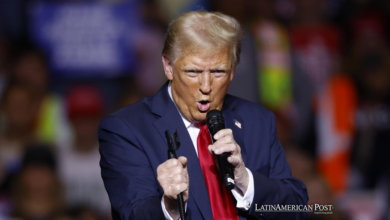U.S.-Mexico Pact Monitors Foreign Investments Amid Chinese Influx
The U.S. and Mexico have agreed to closely monitor foreign investments, particularly from China, to address national security risks and enhance economic cooperation, marking a significant step in their deepening bilateral relationship.

08/12/2023.- A handout photo made available by the Presidency of Mexico shows Mexican president Andres Manuel Lopez Obrador (R) greeting US Treasury Secretary Janet Yellen during a work meeting at the National Palace in Mexico City, Mexico. EFE/EPA/Presidency of Mexico
The Latin American Post Staff
Escucha este artículo
Leer en español: México y Estados Unidos Pactan Monitorear Inversión Extranjera en Medio de Afluencia China
In a strategic move reflecting the evolving geopolitical landscape, the United States and Mexico have joined forces to monitor foreign investments more closely, with a keen eye on the growing influx of Chinese capital into Mexico. This agreement, a hallmark of their strengthened partnership, aims to safeguard national security and foster deeper economic ties.
During a news conference in Mexico City, Treasury Secretary Janet Yellen underscored the significance of this initiative. This move isn't merely about increasing trade; it's about ensuring resilience in supply chains and coordinating investment screening to address shared concerns over foreign investments, particularly from China.
The impetus behind this collaboration is the U.S.'s concern over Chinese purchases of sensitive American technology, which could be accessed via U.S. trading partners like Mexico. The U.S.-Mexico agreement is a strategic measure to mitigate this risk, ensuring that such critical technologies remain secure.
Broadened Focus: Beyond China, Upholding National Security Interests
Yellen emphasized that the engagement with Mexico transcends China-focused concerns. The overarching goal is to ensure foreign investments don't implicate national security concerns. This statement reaffirms the U.S. commitment to a broader approach that encompasses not just economic prosperity but also the safeguarding of national security interests.
The partnership is a testament to the close ties between the U.S. and Mexico, extending beyond trade to encompass critical national security issues. The U.S. remains Mexico's top trading partner, with bilateral trade exceeding $850 billion in 2022. However, China's growing investments in Mexican companies and status as the fastest-growing source of foreign investment in Mexico necessitate a more vigilant approach to investment screening.
The new agreement addresses the risks that certain foreign investments, especially in sensitive technologies, critical infrastructure, and data, can pose to national security. This collaborative effort between the U.S. and Mexico underscores the importance of vigilance in a world where technological advancements and data security are paramount.
Negotiating Opportunities: Impact on Remittances and Economic Landscape
For Mexico, this agreement opens new avenues for negotiation, particularly concerning remittances, a significant source of income for the country. Mexican Finance Minister Rogelio Ramírez de la O views this as an opportunity to negotiate reduced remittance costs. Yellen echoed this sentiment, recognizing the mutual benefits of reducing remittance costs across the border. Such a development could substantially impact the Mexican economy, which is set to receive a record of more than $64 billion in remittances in 2023, representing almost 4% of its GDP.
Ramírez de la O acknowledged the need for Mexico to update its investment analysis methods, prioritizing sectors like lithium, which is crucial to national security. This highlights Mexico's proactive stance in safeguarding its economic and security interests.
The U.S.-Mexico agreement transcends a bilateral framework, reflecting broader global economic dynamics. White House National Security Council spokesman John Kirby emphasized that the U.S. doesn't ask countries to choose between the U.S. and China regarding economic opportunities. Instead, the U.S. is keen on providing economic alternatives that contrast with the less transparent and high-interest loans other nations offer. This approach respects national sovereignty while presenting viable financial options.
The Biden administration's recent actions, including banning exports of advanced computer chips to China and regulating high-tech U.S.-based investments heading towards China, signify a broader strategic shift. These measures, reflective of an intensifying economic competition between the world's two largest economies, demonstrate the U.S.'s resolve to protect its technological edge.
Complex U.S.-China Relations: Balancing Cooperation and Competition
Despite these protective measures, the U.S. remains committed to stabilizing its relationship with China. The meeting between President Joe Biden and Chinese President Xi Jinping in November, where they agreed to combat illegal fentanyl trafficking and reestablish military communications, is a case in point. However, deep-seated differences in economic competition and global security threats persist, underscoring the complex nature of U.S.-China relations.
Also read: Uruguay and China Strengthen Economic Ties for Trade Opportunities
During her visit to Mexico, Yellen also promoted her agency's new strike force to combat illicit fentanyl trafficking, a collaborative effort involving the U.S. and China. This initiative is part of broader efforts to curb the movement of the potent opioid and related drug-making materials into the U.S., highlighting the multifaceted nature of U.S.-China-Mexico relations.
The U.S.-Mexico agreement to monitor foreign investments, particularly from China, is a significant development in their bilateral relationship. It reflects a shared commitment to safeguarding national security and economic interests in an increasingly interconnected and complex global landscape. This pact is a strategic maneuver to counter potential threats and a testament to the deepening economic and security ties between the U.S.




